Archive for January, 2019
Universe Sandbox at the American Astronomical Society Conference
Jan 30th
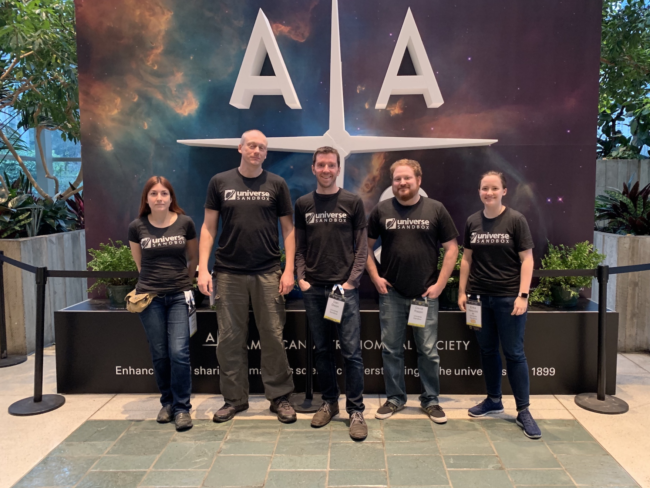
Super Bowl of Astronomy
In early January we gathered some of our team in Seattle, Washington to show off Universe Sandbox at the 233rd meetup of the American Astronomical Society (AAS).
We’ve attended other conferences before that focus on video games, like PAX, but AAS gave us an opportunity to show Universe Sandbox to a different crowd. If you are a researcher, educator, science journalist, or student in the world of astronomy, then AAS is the go-to conference, what some call the “Super Bowl of Astronomy.” And while the government shutdown meant that hundreds of NASA employees who planned on attending couldn’t go, there was still plenty of folk there who had never heard of Universe Sandbox and wanted to learn more.

Come for the Collisions, Stay for the Accurate Mass Loss
Drawing people into our booth was helped a bit by two gigantic TVs showing off some of the usual Universe Sandbox scenarios — you know the ones: Earth melting, stars exploding, moons ripping apart under massive tidal stress.
But what made many attendees stick around and talk to us was the fact that what we were showing not only looked great, but it was also based in science. Universe Sandbox: Come for the fiery collisions, stay for the accurate mass loss when Ceres makes a near pass of a white dwarf!
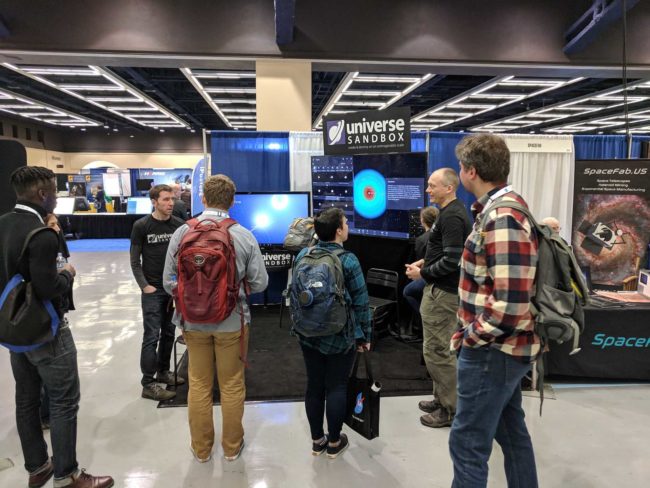
Communicating with Universe Sandbox
In talking to AAS attendees, we hoped to show the potential for using Universe Sandbox for education and visualizations. While most Universe Sandbox players know and appreciate how useful it can be as an educational tool, we want to make sure it gets used in actual classrooms. We believe Universe Sandbox makes it quick and easy to demonstrate astronomy and physics concepts with intuitive and interactive experiments. But don’t take our word for it — here’s astronomy YouTuber Scott Manley with a similar message.
And beyond the classroom, it’s just as quick and easy to use Universe Sandbox for creating visualizations for research, lectures, and articles. There are more sophisticated tools for gathering data with the accuracy needed for research, but there’s nothing quite as convenient as Universe Sandbox for then using the data to create a visual representation, as shown here with the discovery of exoplanets around our nearby star Wolf 1061.
If you’re an educator, a researcher, or are otherwise curious how you can use Universe Sandbox for science communication, please get in touch!
Hiring a Spaceship Physics Developer
Jan 25th
Giant Army is looking for a physics developer to join our team. You will work with our senior physics developer, team scientists, and other developers to add the necessary physics and simulation code to bring realistic, sandbox-style spaceships to Universe Sandbox.
This is a full-time, remote position.
Join us. We’re making something incredible that’s unlike anything else.
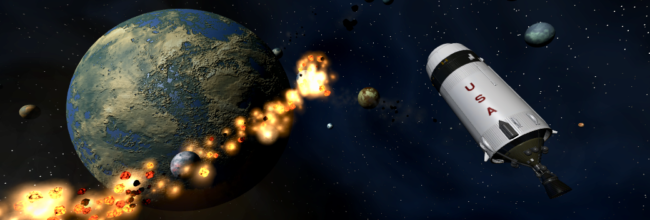
Your Role
- Develop rigid body simulation within our existing custom physics engine (we do not and cannot use Unity’s built-in physics)
- Build upon the rigid body simulation and innovate with spaceship features such as:
- Thrusters
- Data-driven historical simulations (Cassini, Voyager, etc.)
- Modular spaceship parts
- Destruction of spacecraft from heating, lasers, and collisions (both from other spacecraft and asteroids/planets/moons)
- Integration with our planned megastructures/tethers feature
Qualifications
- (Strong C# && Unity Engine experience) || (Experience with an entity component model && object-oriented programing)
- Experience with physics engine development
- Familiar with version control (we use GitHub), task-management systems (we use GitHub+ZenHub), unit tests, code reviews, and so forth
- Self-driven; comfortable working collaboratively and remotely
- Appreciation for, and focus on, realism and detail
- Passion for science, astronomy, spaceships, and real-time interactive simulations
- Love of fantastical what-if scenarios: what-if.xkcd.com (note citation #6 on 148)
Company Overview
Giant Army is the company behind Universe Sandbox. Our headquarters are in Seattle, Washington, USA, with team members across the United States, Germany, and Denmark.
Team members enjoy a flexible, collaborative environment. We strive for work-life balance, and we pursue the features that get us excited about science. We do the work so we can share it with others. We’re committed to creating an accessible experience that can’t be found elsewhere.
Science is for everyone, and we welcome all qualified applicants.
Product Overview
Universe Sandbox is a space simulator that merges real-time gravity, climate, collision, and physical interactions to reveal the beauty of our universe and the fragility of our planet. It’s more than a game; it’s a way of experiencing and learning about reality in a way that’s never been done before.
Universe Sandbox is available on Windows, Mac, Linux, and VR with mobile and future platforms planned. We’ve sold nearly half a million copies and have a “Very Positive” rating on Steam with 93% positive user reviews.
How to Apply
Resume and code sample required. Please either upload or include links.
Hiring a Graphics Developer
Jan 25th
This position has been filled. Thank you to everyone who applied.
If this still sounds like an ideal job for you, please reach out. We are always looking for more help from the right candidates.
Giant Army is looking for a graphics developer to join our team and help improve Universe Sandbox. You will be working closely with our team’s senior graphics developer to help develop, improve, and maintain assets and visual effects. As your skills and experience with the position grow, you will begin to research and develop entire visual subsystems of Universe Sandbox.
This is a full-time, remote position.
Join us. We’re making something incredible that’s unlike anything else.
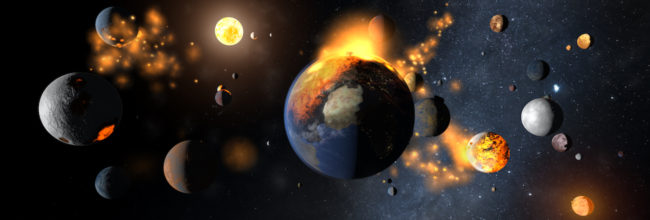
Your Role
- Maintain focus on interactive, realistic, and scientifically-accurate visual representations
- Work independently with guidance from our senior graphics developer, team scientists, and director
- Maintain source assets by integrating new data, such as updated elevation maps
- Prepare assets for use in the engine, such as importing and error checking models and textures, and creating and assigning materials
- Procedurally or manually generate textures for shader effects and surfaces
- Develop and maintain code used to connect visual and simulation systems
Qualifications
- (Strong C# & Unity Engine experience) || (Experience with an entity component model & object-oriented programming)
- Strong understanding of graphics pipelines, rendering techniques, and graphics-related math
- Experience writing and optimizing shaders (HLSL, GLSL, Cg)
- Appreciation for, and focus on, realism and detail
- Familiar with version control (we use GitHub), task-management systems (we use GitHub+ZenHub), code reviews, and so forth
- Self-driven; comfortable working collaboratively and remotely
- Passion for science, astronomy, and real-time interactive simulations
- Love of fantastical what-if scenarios: what-if.xkcd.com (note citation #6 on 148)
Company Overview
Giant Army is the company behind Universe Sandbox. Our headquarters are in Seattle, Washington, USA, with team members across the United States, Germany, and Denmark.
Team members enjoy a flexible, collaborative environment. We strive for work-life balance, and we pursue the features that get us excited about science. We do the work so we can share it with others. We’re committed to creating an accessible experience that can’t be found elsewhere.
Science is for everyone, and we welcome all qualified applicants.
Product Overview
Universe Sandbox is a space simulator that merges real-time gravity, climate, collision, and physical interactions to reveal the beauty of our universe and the fragility of our planet. It’s more than a game; it’s a way of experiencing and learning about reality in a way that’s never been done before.
Universe Sandbox is available on Windows, Mac, Linux, and VR with mobile and future platforms planned. We’ve sold nearly half a million copies and have a “Very Positive” rating on Steam with 93% positive user reviews.
How to Apply
This position has been filled. Thank you to everyone who applied.
If this still sounds like an ideal job for you, please reach out. We are always looking for more help from the right candidates.
2018 Retrospective
Jan 7th
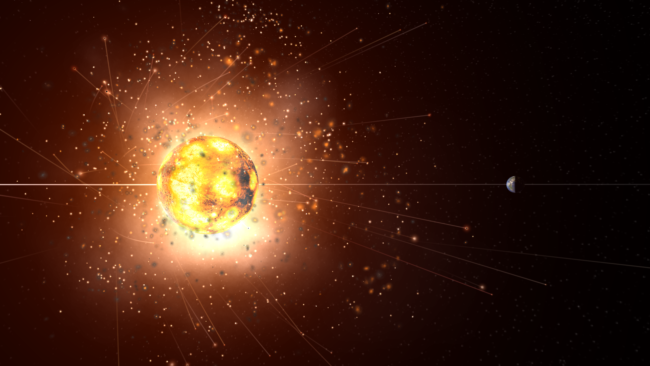
Happy New Year!
Before we take a look at what’s coming to Universe Sandbox this year, let’s take a look back at our achievements in 2018, by the numbers:
1
new team member: welcome, Jules, our new sound designer!
2
the # that was dropped from the logo.
That’s right, now it’s just Universe Sandbox. We’ll have more to say about this soon!
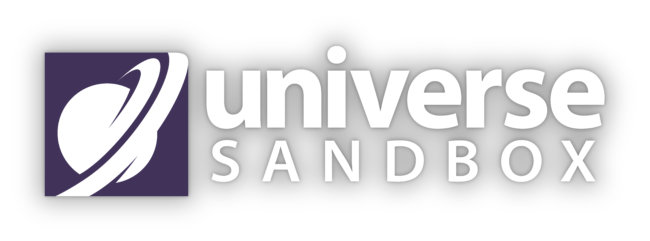
8
# of significant updates to Universe Sandbox.
- They Put a Car in Space, We Upgraded Our Engine | Update 20.5 | March 7, 2018
- More Super Supernovae | Update 20.6 | March 15, 2018
- This Hyperbolic Update Will Change Your Life | Update 20.7 | May 24, 2018
- 20 Earth Languages & 12 Jovian Moons | Update 21 | July 19, 2018
- Windows Mixed Reality Support | Update 21.2 | August 02, 2018
- The Extremes of Our Solar System | Update 21.3 | October 04, 2018
- The Universe Just Got Bigger: Steam Workshop Support | Update 22 | November 15, 2018
- Far Out | Update 22.1 | December 20, 2018
12
# of Universe Sandbox team members that fit into one house in Spain for a week.

21
# of new simulations.
- 2 Parker Solar Probe sims
- 2 Tesla Roadster sims
- 2 sims of Jupiter’s newly discovered moons
- New Horizons Ultima Thule Encounter in 2019
- 2018 VG18: The Most Distant Object in the Solar System
- 2015 TG387: A Goblin at the Edge of the Solar System
- Voyagers 1 & 2 Start 2019 Outside the Solar System
- Ultimate Engineered System
- Solar System with No Sun
- Kepler 10
- Kepler 47 Binary System
- Alpha Centauri Triple System
- Saturn & Earth
- Retrograde Asteroid 2015 BZ509
- Interstellar Object with a Hyperbolic Trajectory
- Solar System with Betelgeuse instead of the Sun
- Conservation of Momentum lesson
- Gravitational Force lesson
This just includes the simulations that we added, though. Scroll down for a much larger number of simulations that our community has shared on Workshop!

22
# of languages now supported in Universe Sandbox.

26
# of pages of release notes for Universe Sandbox updates in 2018.
Check out What’s New.
325
# of bugs fixed.
You know what they say, fixing a bug a day keeps the QA away. Just kidding, we can’t — and don’t want to — stop our awesome QA, Mat, from hunting down bugs in Universe Sandbox.
Not all of these bug fixes were notable for releases, as there are many bugs that are discovered and fixed while we’re still doing behind-the-scenes work with improving Universe Sandbox. We look forward to squashing hundreds more this year!
479
Highest # of concurrent users in Universe Sandbox in 2018 (happened on the week of August 6).
This is the fifth highest of all time for us.
1,114
# of positive Steam reviews of Universe Sandbox written in 2018.
All this love for Universe Sandbox really warms our cold, spaceborne hearts. <3

2,420
# of simulations shared on Steam Workshop.
That means there are literally thousands of simulations featuring alien planets and systems, recently discovered exoplanets, confounding scientific phenomena, worlds from movies, books, and other video games, and of course bizarre bugs (or are they features?), created by you, the community, now shared on Steam Workshop. We look forward to seeing this treasure trove continue to grow.
7,160
# of copies of Universe Sandbox donated for charity.
This year we donated copies to StackUp for distribution to military personnel, donated proceeds to the National Center for Science Education, provided copies to schools and educational organizations, and donated copies for various fundraisers for people doing awesome things, like all the folks at CosmoQuest.
12,694
# of objects added to the Universe Sandbox database.
That’s 11,973 new Solar System objects, 387 new exoplanets, 310 new stars, 21 new moons, 2 new human-scale objects, and 1 new galaxy.
95,736
# of messages sent on Slack.
We’re a remote team, so other than some video chats and comments on GitHub, all of our conversations happen on Slack. It’s what makes our collaboration on Universe Sandbox possible!
>100,000
# of copies sold on Steam and other platforms.
Or, on average, one copy sold every five minutes — comfortably keeping pace with last year!
4,506,463
# of views of Markiplier’s two recent videos featuring Universe Sandbox.
These were the most watched Universe Sandbox videos on YouTube this year. And this brings the total number of views of Markiplier’s Universe Sandbox videos to… 35,522,196. Granted, 24 million of those views are on the so-catchy-you-really-will-regret-being-reminded-of-it Space is Cool remix, but we’ll take some credit for providing a bit of inspiration and a nice backdrop for Markiplier’s auto-tuned cries of love for space. Many thanks to Markiplier for helping spread the word!
Can you BLOW UP a BLACK HOLE: https://youtu.be/LW6S74J4kA8
1000 WAYS to DESTROY EARTH: https://youtu.be/4FEdjWW98QI
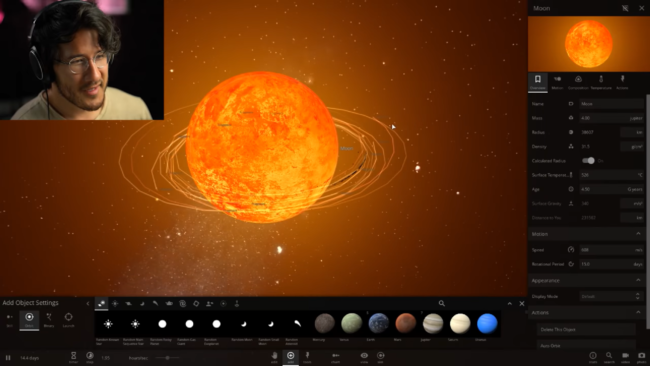
>6,000,000
# of supernovae in Universe Sandbox.
According to our analytics, y’all have exploded more than 6 million stars. Needless to say, that’s an accomplishment.

What’s Next?
Our big features this year were Localization (support for other languages) and Steam Workshop. A lot of time and effort went into these features, and we think they’re a pretty big deal — Localization opens up Universe Sandbox for the first time to people all over the world, and support for Workshop has made it super easy to check out an ever increasing catalogue of simulations made by people pushing the limits of Universe Sandbox.
But we also recognize that these features did not change any aspects of the simulation itself. And the simulation is the heart of Universe Sandbox. While we made a number of some smaller improvements and fixes related to the simulation, we unfortunately ran into continual issues with two big updates that we had hoped to get out this year — Surface Grids / Lasers and a physics rewrite. Surface Grids will allow for more detailed surface simulation, including localized temperatures, which makes possible things like heating from lasers. The physics rewrite should greatly increase physics performance and pave the way for additional physics-related features, like megastructures.
We hope to have more news about Surface Grids soon, along with some insight into some of the obstacles we’ve faced with its development. We also continue to work on other projects like new star audio, a new tutorial system, a VR interface overhaul, new galaxies, a mobile version, and continual improvements to the overall experience.
We thank all of you for your continued support of Universe Sandbox! This year we remain committed to improving Universe Sandbox as we develop and plan new features, upgrades, and fixes for 2019 and the years to come.
– The Universe Sandbox Team
Dan, Chris, Georg, Alexander, Jenn, Jonathan, Dave, Rappo, Mat, Jacob, Erika, Jules, and Jared
